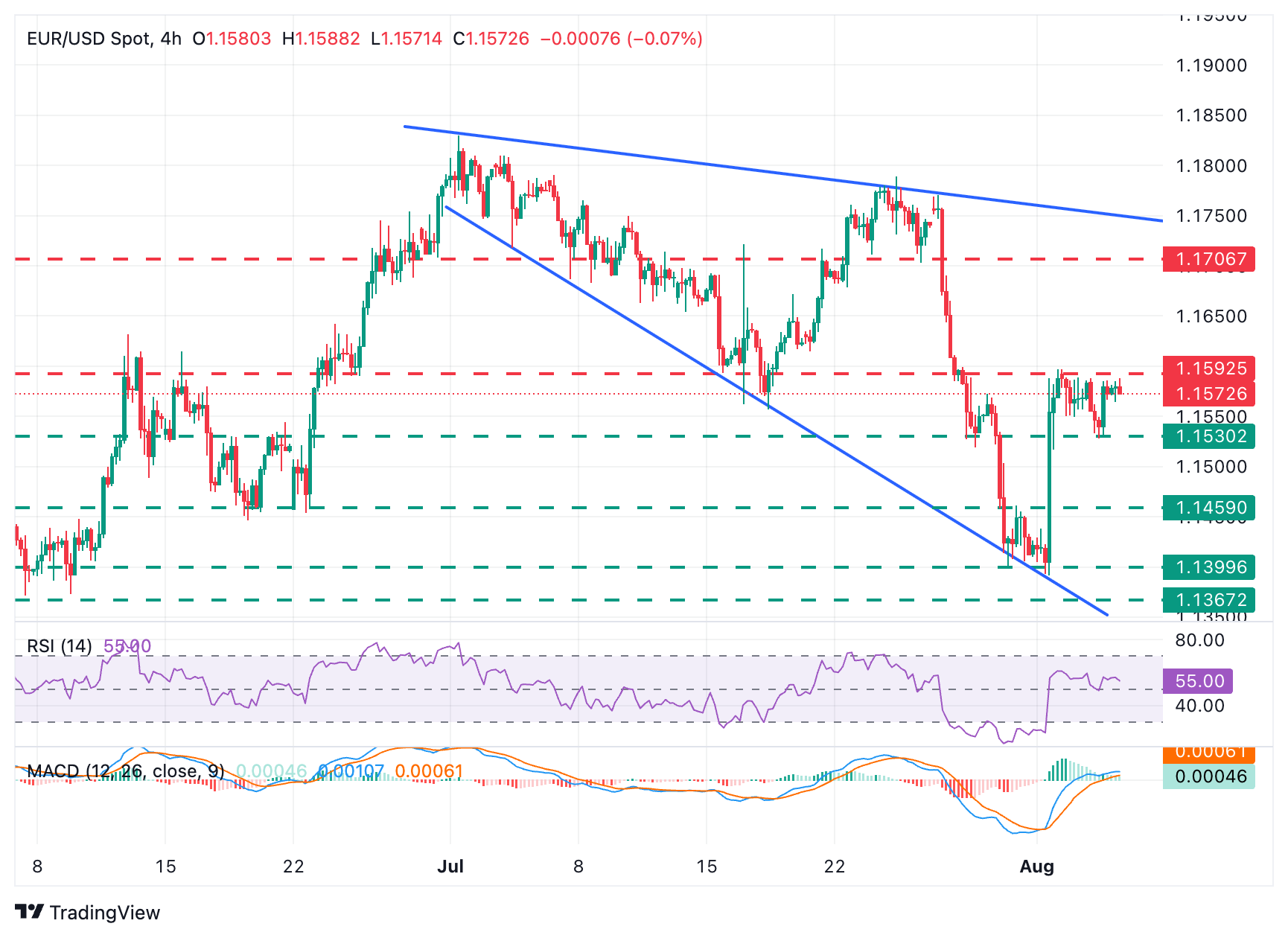EUR/USD consolidates gains as US data revives stagflation concerns
- The Euro trades sideways, with concerns about the US economy undermining confidence in the US Dollar.
- Weak services activity data, together with higher prices and declining employment, have revived fears of stagflation.
- Technically, the EUR/USD keeps the broader bearish trend intact while below 1.1600.
The EUR/USD pair is consolidating gains near weekly highs as the US Dollar languishes, following an unexpectedly weak services sector report that cast further doubts on the momentum of the United States (US) economy. The data revived market concerns about stagflation that had caused a significant depreciation of the US Dollar in previous months.
The Euro (EUR) is trading practically flat, a few pips short of 1.1600 in the early European session on Wednesday, after bouncing from 1.1530 lows on Tuesday. The pair holds most of the gains taken on Friday after the release of a grim US Nonfarm Payrolls (NFP) report that boosted expectations that the Federal Reserve (Fed) will be forced to cut interest rates in the coming months.
US services PMI figures released on Tuesday revealed that the sector’s activity slowed down to levels close to stagnation in July, with the employment sub-index showing an accelerating decline, prices increasing to their highest reading in almost three years, new orders stalling, and export orders plunging.
These figures come after a sharp downward revision of last month’s employment figures to confirm that the effects of Trump’s tariffs are starting to filter into the US economy, hampering economic growth, and boosting inflation, a mix that will pose a serious challenge for the Federal Reserve when deciding on rates.
In the meantime, speculation that US President Donald Trump will replace Adriana Kugler’s vacancy in the Fed Governor’s board with a loyalist, and name the replacement for Chairman Jerome Powell well ahead of the end of his term, in May next year, might undermine confidence in the bank’s independence and put additional pressure on the USD.
In Wednesday’s calendar, the Eurozone retail sales will be the main attraction during the European session. In the US, Federal Reserve officials Susan Collins, Lisa Cook, and Mary Daly are due to speak, and their comments about the recent US macroeconomic data will be analyzed with interest for further clues about the outcome of September’s monetary policy meeting.
Euro PRICE Today
The table below shows the percentage change of Euro (EUR) against listed major currencies today. Euro was the strongest against the US Dollar.
| USD | EUR | GBP | JPY | CAD | AUD | NZD | CHF | |
|---|---|---|---|---|---|---|---|---|
| USD | -0.07% | -0.05% | -0.15% | -0.03% | -0.35% | -0.25% | -0.16% | |
| EUR | 0.07% | 0.00% | -0.09% | 0.03% | -0.18% | -0.22% | -0.09% | |
| GBP | 0.05% | -0.01% | -0.08% | 0.03% | -0.20% | -0.24% | -0.04% | |
| JPY | 0.15% | 0.09% | 0.08% | 0.10% | -0.24% | -0.21% | 0.04% | |
| CAD | 0.03% | -0.03% | -0.03% | -0.10% | -0.21% | -0.27% | -0.08% | |
| AUD | 0.35% | 0.18% | 0.20% | 0.24% | 0.21% | -0.04% | 0.15% | |
| NZD | 0.25% | 0.22% | 0.24% | 0.21% | 0.27% | 0.04% | 0.19% | |
| CHF | 0.16% | 0.09% | 0.04% | -0.04% | 0.08% | -0.15% | -0.19% |
The heat map shows percentage changes of major currencies against each other. The base currency is picked from the left column, while the quote currency is picked from the top row. For example, if you pick the Euro from the left column and move along the horizontal line to the US Dollar, the percentage change displayed in the box will represent EUR (base)/USD (quote).
Daily digest market movers: Weak US data is undermining confidence in the US Dollar
- July’s ISM Services Purchasing Managers Index (PMI) fell to 50.1 from 50.8 in June, against expectations of an increase to 51.5. The prices index escalated to 69.9, its highest reading since October 2022, from 67.5 in June, and the employment index contracted further to 46.4 from 47.2.
- Meanwhile, uncertainty about trade tariffs remains high. Trump threatened to impose higher tariffs on China and India for buying Russian Oil, flagged 35% tariffs on the European Union if they failed to honour the USD 600 billion investment agreed last week, and warned that pharmaceuticals would face a levy of up to 250%.
- Data from Germany released on Wednesday has shown that German Factory Orders fell 1% in June, against expectations of a 1% increase. June’s decline follows a 1.4% drop in May, adding to the evidence of the weak momentum of the Eurozone’s largest economy.
- Later on Wednesday, Eurozone Retail Sales are expected to show a rebound to 0.4% in June, following a 0.7% contraction in May. Year-on-year, retail consumption is seen accelerating to 2.6% from 1.8% in the previous month.
EUR/USD stalls below key resistance at 1.1600

EUR/USD is trading sideways this week, consolidating gains in a narrow range, following Friday’s rally. The broader trend, however, remains biased lower from early-July highs. Intra-day charts show technical indicators are flattening, highlighting a lack of clear momentum, with investors awaiting Trump’s nominee for the vacancy in the Fed’s committee and the candidate for the central bank’s chair.
Resistance at the 1.1600 area (August 1and 4 highs) is holding bulls for now. If that level is broken, the next upside targets would be at the 1.1700-1.1710 area, where the pair found support on July 23 and 25, and the trendline resistance at 1.1750. Supports are at Tuesday’s low, 1.1530, and below here, the July 31 high, at 1.1460, ahead of the August 1 low, at 1.1400.




